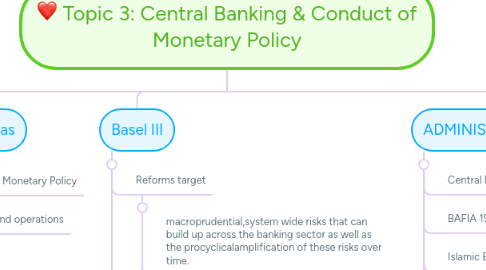
1. CAMEL
1.1. Capital Adequacy Framework = C
1.1.1. Support ups and downs of business
1.1.2. Cushion on unexpected losses
1.1.3. Continuing commitment of shareholders
1.2. Asset Quality = A
1.2.1. Poor credit evaluation
1.2.2. Connected lending to directors or staff
1.2.3. Criminal breach of trust
1.2.4. Risk diversification
1.3. Management = M
1.3.1. Integrity
1.3.2. Professional competence
1.3.3. Qualities of Service
1.4. Earning Capacity = E
1.4.1. Interest Income
1.4.2. Interest Expenses
1.4.3. Non Interest Income/ Off Balance Sheet Activities
1.5. Liquidity Framework = L
1.5.1. Effort to enhance liquidity management in banking instituitions
1.5.1.1. provide bank with a better means of assessing present or future liquidity positions
2. The Need for Central Bank
2.1. Prudent conduct of monetary policy
2.2. Financial system stability
2.3. Developmental role
2.4. Promotes financial inclusion
2.5. Banker and adviserto the Government
3. Functional Areas
3.1. Economics & Monetary Policy
3.2. Investment and operations
3.3. Regulation
3.4. Payment System
3.5. Supervision
3.6. Organizational Development
3.7. Communication
4. Basel III
4.1. Reforms target
4.1.1. macroprudential,system wide risks that can build up across the banking sector as well as the procyclicalamplification of these risks over time.
4.1.2. bank-level, or microprudential, regulation, which will help raise the resilience of individual banking institutions to periods of stress.
4.2. Aim
4.2.1. improve the banking sector's ability to absorb shocks arising from financial
4.2.2. improve risk management and governance
4.2.3. strengthen banks' transparency and disclosures.
4.3. Comprehensive set of reform measures to strengthen
4.3.1. regulation
4.3.2. supervision
4.3.3. risk management
5. ADMINISTERED LEGISLATIONS
5.1. Central Bank of Malaysia Act 2009
5.2. BAFIA 1989
5.3. Islamic Banking Act 1983
5.4. Insurance Act 1996
5.5. Exchange Control Act 1953
5.6. Takaful Act 1984
5.7. Development Financial Institution Act 2002
5.8. AMLA 2001
5.9. Payment System Act 2003
5.10. Money Changing Act 1998
6. BAFIA
6.1. Need for BAFIA
6.1.1. Regulate operation & conducts financial institutions
6.1.1.1. Money
6.1.1.2. Discount Houses
6.1.1.3. FOREX Brokers
6.2. Powers of Supervision
6.2.1. monitor and control financial institutions more effectively
6.3. Consequences of Breaches
6.3.1. Non-adherence to the law could result in serious criminal violation of law
6.3.1.1. where prosecutors will seek criminal sanctions against the bank.
6.3.2. provides for Scheduled Offences and Penalties as set out in the Fourth Schedule.
6.3.2.1. jail term
6.3.2.2. fines
6.4. Institutions Under BAFIA
6.4.1. Licensed Institutions
6.4.2. Scheduled Institutions
6.4.3. Non Scheduled Institutions
6.5. Major Provisions in BAFIA
6.5.1. Powers and Duties of Auditors
6.5.2. Deposit taking
6.5.3. Shareholding
6.5.4. Powers of Investigation, Search & Seizure
6.5.5. Secrecy
6.5.6. Electronic Fund Transfer
6.5.7. Penalties
6.5.8. Local Incorporation
7. Definition
7.1. Central Banking
7.1.1. Example: Bank Negara Malaysia
7.1.1.1. Example: Bank Negara Malaysia

